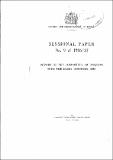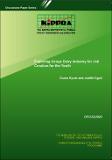Discussion Paper No. 328 of 2024 on An Assessment of Kenya’s Sustainable Smart Dairy Farming: Trends and Scenario Analysis
Publication Date
2024Author
Type
KIPPRA Publicationsviews
downloads
Metadata
Show full item recordBy
Momanyi, Dorah & Pepela, Faith
Abstract/
Smart dairy farming uses advanced sensing and analyzing technologies to reduce environmental issues, raise animal health, and meet the demand for milk and milk products. The sustainable adoption and use of this system in developing countries is limited given the high initial capital-intensive technologies, inadequate capabilities, and infrastructure. As such, many developing economies like Kenya have experienced low yields, milk waste and losses, compromised animal welfare, and environmental degradation. This paper analyses trends and develops scenarios in the dairy sector using a qualitative foresight approach employing a literature review approach, intuitive data analysis, and the Delphi technique. The findings from this study first suggest that the adoption of emerging trends such as dairy intensification, dairy automation, and environmental sustainability could improve productivity and processes throughout the dairy value chain. Secondly, land intensification, animal welfare, technology, greenhouse emissions, research, and development, rising incomes, and resource scarcity are key drivers that stakeholders could look out for and find ways to mitigate their effects. Finally, the multiple futures in the dairy industry could require high investment in animal welfare to support changing consumer preferences, green purchasing, and efficient use of land resources to meet the projected increase in demand for milk particularly in developing countries. Kenya’s dairy sector thus holds significant potential for growth and sustainability. The government could repurpose agricultural policies and financing mechanisms to support the adoption and scaling of smart dairy technologies by smallholder farmers. In addition, they could establish robust regular data collection and analysis systems on the key drivers to monitor how they evolve to support quick response and redesigning of the industry. Finally, stakeholders could capacity-build smallholder farmers and consumers on the nexus between dairy farming and environmental sustainability to enable consumers to purchase environmentally friendly animal products and smallholders to adopt sustainable and resilient smart dairy techniques.
Publisher
The Kenya Institute for Public Policy Research and Analysis (KIPPRA)Series
DP/328/2024;Collections
- Discussion Papers [346]
Related items
Showing items related by title, author, creator and subject.
-
Discussion Paper No.232 of 2020 on Exploring Kenya Dairy Industry for Job Creation for the Youth
Kyule, Grace; Nguli, Judith (The Kenya Institute for Public Policy Research and Analysis (KIPPRA), 2020)This study is based on the value chain approach to assess key constraints to growth of the dairy industry in Kenya, to explore the current job creation potential of the industry and to assess its labour skills requirements ... -
Sessional Paper No. 09 of 1956/1957 on the Report of The Committee of Enquiry into the Dairy Industry
Colony and Protectorate of Kenya (The Government Printer, 1956)The Minister for Agriculture appointed a Committee to enquire into the Dairy Industry of Kenya in September, 1955, with the following terms of reference: To consider whether some form of statutory control of the dairy ... -
Discussion Paper No. 232 of 2020 on Exploring Kenya Dairy Industry for Job Creation for the Youth
Kyule, Grace ; Nguli, Judith (The Kenya Institute for Public Policy Research and Analysis (KIPPRA), 2020)This study is based on the value chain approach to assess key constraints to growth of the dairy industry in Kenya, to explore the current job creation potential of the industry and to assess its labour skills requirements ...



